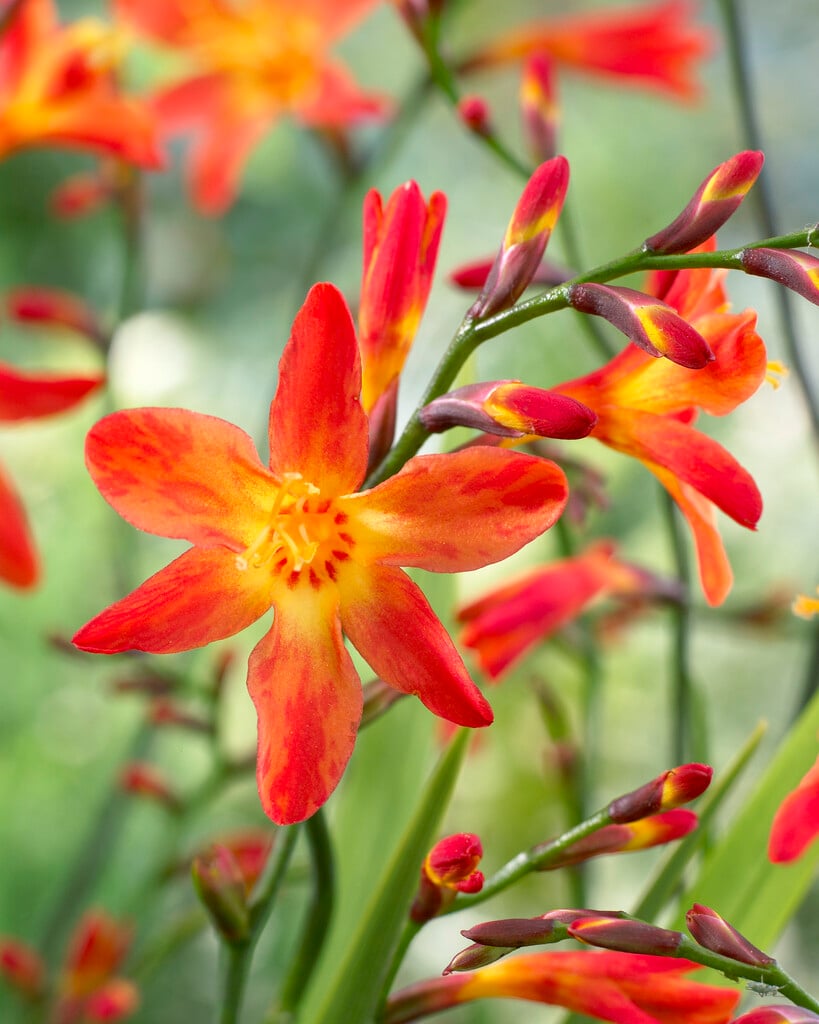Crocosmia × crocosmiiflora 'Carmin Brillant'
montbretia 'Carmin Brilliant'
A cormous, clump-forming, herbaceous perennial with an elegant growing habit up to 80cm tall when in flower. It has mid-green, blade-like leaves and arching flower stems that bear an abundance of red buds that develop into long-lasting and intense, dark orange, tubular flowers that have a yellow throat marked with reddish blotches from mid to late summer
Synonyms
Crocosmia 'James Coey' hort.Crocosmia 'Carmin Brilliant'
see moreCrocosmia × crocosmiiflora 'James Coey' misapplied
Size
Ultimate height
0.5–1 metresTime to ultimate height
2–5 yearsUltimate spread
0.1–0.5 metresGrowing conditions
Moisture
Moist but well–drainedpH
Acid, Alkaline, NeutralColour & scent
| Stem | Flower | Foliage | Fruit | |
| Spring | Green | |||
|---|---|---|---|---|
| Summer | Orange Yellow Red | Green | ||
| Autumn | Orange Yellow Red | Green | ||
| Winter |
Position
- Partial shade
Aspect
South–facing or West–facing or East–facing
Exposure
Exposed or Sheltered Hardiness
H4Botanical details
- Family
- Iridaceae
- Native to GB / Ireland
- No
- Foliage
- Deciduous
- Habit
- Clump forming
- Genus
Crocosmia are deciduous cormous perennials with erect, sword-shaped leaves and branched spikes of showy, funnel-shaped flowers in summer
- Name status
Accepted
How to grow
Cultivation
Corms should be planted in moderately fertile, humus rich soil approximately 10cm deep and 7.5–10cm apart in groups to form clumps. Water if it is a dry season as a lack of water reduces flowering. This species is listed on Schedule 9 of the UK Wildlife and Countryside Act as an invasive, non-native species. While this does not prevent it or its cultivars from being sold in the UK, or from being grown in gardens, the RHS encourages those that do grow it to take great care with managing it and with disposing of unwanted material to ensure that it does not spread outside of the garden.
Propagation
Please see cultivation notes
Suggested planting locations and garden types
Pests
May be susceptible to glasshouse red spider mite
Diseases
Generally disease-free
Love gardening
Sign up to receive regular gardening tips, inspiration, offers and more
View our Privacy Policy
Get involved
The Royal Horticultural Society is the UK’s leading gardening charity. We aim to enrich everyone’s life through plants, and make the UK a greener and more beautiful place.

